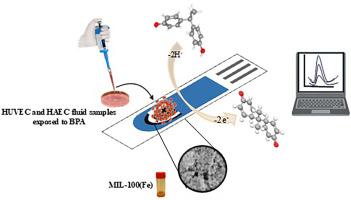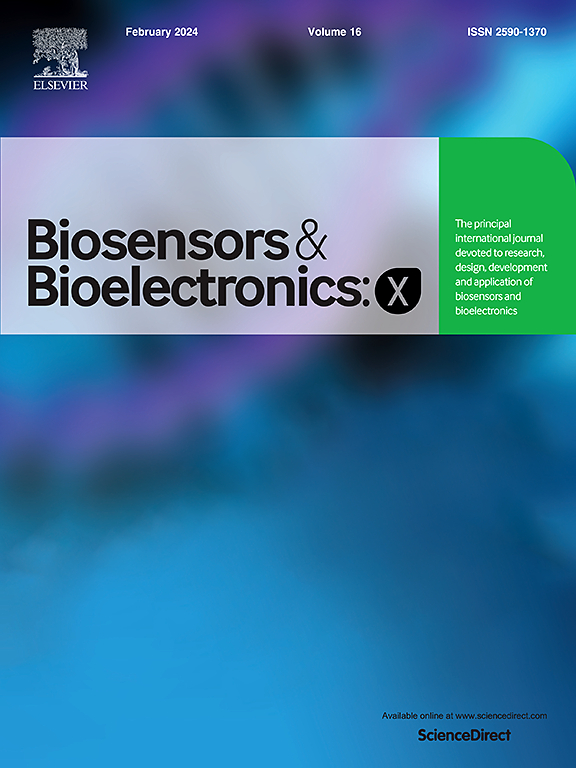用于双酚A检测的简单mof纳米传感器:在人内皮细胞模型上清液中的体外应用
IF 10.61
Q3 Biochemistry, Genetics and Molecular Biology
引用次数: 0
摘要
本工作描述了一种用于双酚a (BPA)检测的简单电化学纳米传感器,该传感器基于铁金属有机框架(MIL-100(Fe))固定在商业多壁碳纳米管(MWCNTs)/金纳米颗粒(AuNPs)修饰的石墨丝网印刷电极(GSPE)上。利用循环伏安法(CV)、电化学阻抗谱(EIS)和SEM-EDX分析对电化学平台进行了表征。MIL-100(Fe)/AuNPs_MWCNTs/GSPE平台具有较好的分析性能,包括宽动态范围(0.1-100 μM)和低检出限(20 nM)。此外,所提出的传感器具有优异的选择性,能够在存在潜在干扰的情况下准确检测BPA。最后,该传感器已成功地在暴露于BPA的人内皮细胞模型、人脐静脉内皮细胞(HUVECs)和人主动脉内皮细胞(HAECs)的上清样品中进行了体外BPA检测。这些发现强调了所提出的纳米传感器在不同浓度和孵育时间暴露于双酚a的个体上清细胞液中检测双酚a的潜力。本文章由计算机程序翻译,如有差异,请以英文原文为准。

A simple MOF-based nanosensor for bisphenol A detection: in vitro application in supernatant of human endothelial cell models
This work describes a simple electrochemical nanosensor for bisphenol A (BPA) detection based on an iron metal organic framework (MIL-100(Fe)) immobilized onto a commercial multiwalled carbon nanotubes (MWCNTs)/gold nanoparticles (AuNPs) modified graphite screen printed electrode (GSPE). The electrochemical platform has been characterized by cyclic voltammetry (CV), electrochemical impedance spectroscopy (EIS) and SEM-EDX analysis. The resulting MIL-100(Fe)/AuNPs_MWCNTs/GSPE platform exhibited competitive analytical performances, including a wide dynamic range (0.1–100 μM), and a low detection limit (20 nM). Additionally, the proposed sensor demonstrated excellent selectivity, enabling accurate BPA detection in the presence of potential interferences. Lastly, the sensor has been successfully tested for in vitro BPA detection in the supernatant samples of human endothelial cellular models, Human Umbilical Vein Endothelial Cells (HUVECs) and Human Aortic Endothelial Cells (HAECs), exposed to BPA. These findings highlight the potential of the proposed nanosensor for the detection of BPA in supernatant cell fluids of individuals exposed to BPA at different concentrations and incubation times.
求助全文
通过发布文献求助,成功后即可免费获取论文全文。
去求助
来源期刊

Biosensors and Bioelectronics: X
Biochemistry, Genetics and Molecular Biology-Biophysics
CiteScore
4.60
自引率
0.00%
发文量
166
审稿时长
54 days
期刊介绍:
Biosensors and Bioelectronics: X, an open-access companion journal of Biosensors and Bioelectronics, boasts a 2020 Impact Factor of 10.61 (Journal Citation Reports, Clarivate Analytics 2021). Offering authors the opportunity to share their innovative work freely and globally, Biosensors and Bioelectronics: X aims to be a timely and permanent source of information. The journal publishes original research papers, review articles, communications, editorial highlights, perspectives, opinions, and commentaries at the intersection of technological advancements and high-impact applications. Manuscripts submitted to Biosensors and Bioelectronics: X are assessed based on originality and innovation in technology development or applications, aligning with the journal's goal to cater to a broad audience interested in this dynamic field.
 求助内容:
求助内容: 应助结果提醒方式:
应助结果提醒方式:


